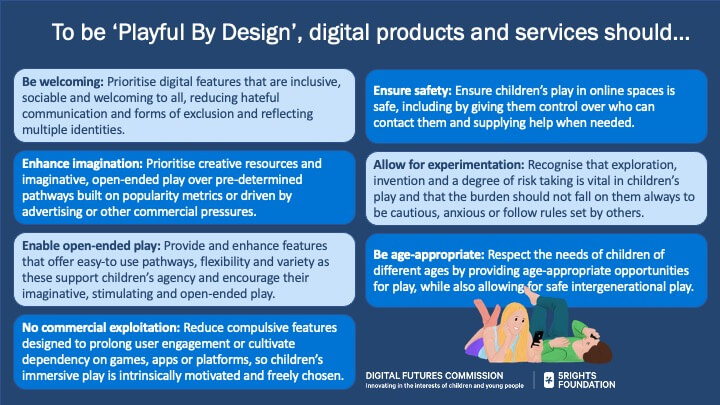By Kruakae Pothong and Sonia Livingstone
Our “Playful by Design” principles – the primary output of the Digital Futures Commission’s applied research to realise children’s right to play in the digital environment – will be presented at the 72nd International Communication Association Conference (ICA) in Paris this week. So, save the date and come talk to us on Saturday 28th May 2022 during our poster presentation.
What we mean by “Playful by Design”
Our ICA presentation draws on consultative and research methods – qualitative and quantitative – to understand how children’s experiences of play compare across non-digital and digital contexts. These ground our 7 “Playful by Design” principles shown below.

These principles summarise the key ingredients that make digital products and services playful and child rights-respecting by design, based on our analysis of the statistical correlation between the qualities that make play valuable to children and the digital features that children encounter. So, if you are designing digital products or services likely accessed by children, these principles offer a recipe for what works for children’s play in the digital environment.
Even if children are not your intended users, these principles matter if you have children among your actual users. We even dare suggest that the principles would work for adults: as we found in our consultation, there’s a child in every grown-up waiting to come out to play!
Watch us talk about the project here.
What are the key takeaways?
One is that children seek similar qualities of playful experience wherever they play. This testimony coincides with growing interest in the metaverse – supposedly designed to converge the physical and digital realities in all aspects of people’s lives. Yet children told us that playing in the playground or outdoors with their friends still offers more of the qualities of free play that really matter to them – diverse, stimulating, open-ended, imaginative, sense of achievement, emotional resonance and safety.
Children also told us in the consultation that the social aspect of their play is almost equally crucial both on the physical playground and online. Especially during the COVID-19 lockdown, digital play has become children’s social lifeline. However, statistical analysis of our national survey with just over 1000 children across the UK shows that the nature of group play online is not very voluntary and that the joy in group play on the playground is driven mainly by children’s own imagination.
If and when the metaverse converges digital and physical worlds for playful activities, how can it continue to enhance children’s imagination while ensuring that children can dip in and out voluntarily without feeling like they have lost or missed anything when they hop out? Will there be a business model to support this?
Knotty problems in designing for free play
Our Playful by Design principles are not instant noodles! These principles intersect and, at times, compete with one another, thus creating some knotty challenges. For example, how do you design an educational game with a set learning objective but allow for imagination and flexible pathways? Or, how do you support children’s experimentation, so they can push some boundaries, make and break their own rules, and learn from their mistakes without making them unsafe? Or, again, how do you make a multi-player game that allows for multi-generational play but make the game age-appropriate even for a 5-year-old?
There is no easy answer to these questions, but we’d like to think of our playful by design principles as a music mixer board. You can’t turn all the notes up or down, and perhaps you can’t support all the qualities of play simultaneously. We hope that our Playful by Design principles will inspire digital designers and developers to mix different qualities of play appropriate to combinations of users – both the intended and unintended ones, the context of use (for example, where this play takes place), and the specific features of their products and services.
***
To encourage future Playful by Design innovations, we are continuing our workshops to playtest our design tool with digital developers to help them make their products and services Playful by Design. More soon!